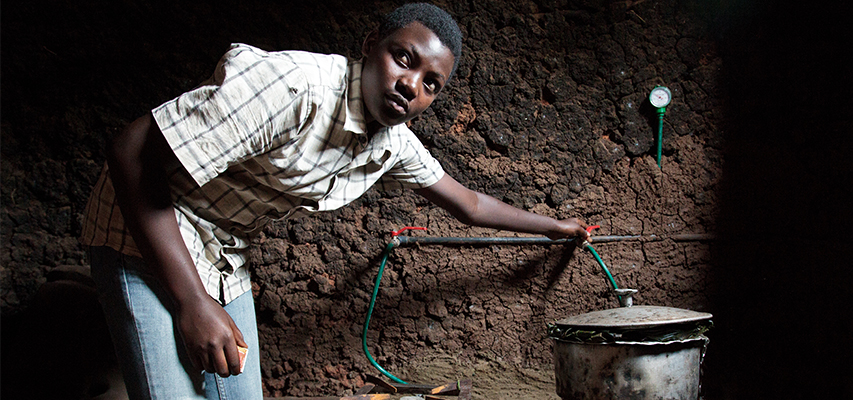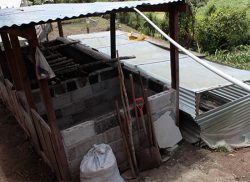
Biogas is an environmentally conscious renewable source, produced through anaerobic digestion, rather than via geological processes.
Environmentally friendly: Bio-digester technology is environmentally friendly, maintenance free and efficient and does not depend on conventional energy sources. The effluent is odorless and gets rid-off most of the pathogens.
Components of bio-digesters: The bio-digester technology has two components: anaerobic microbial consortium and a specially designed fermentation tank to produce biogas from human waste (also known as septage).

Correct use of bio-digesters: A bio-digester must be used constantly; otherwise, a process of putrefaction sets in within the container. When this occurs, the container must be emptied, and the system cleaned.
1957: Year the first attempt was made to exploit biogas for energy in Kenya with a bio-digester using coffee pulp
It’s a much-needed alternative source of energy
Kenya, like many other developing nations, relies heavily on unclean energy as it struggles to cater for its growing population. The expanding manufacturing sector is also pushing up the country’s power needs.
Over 95 percent of the country’s electricity is generated from hydro-stations and geothermal plants, with renewed interest in wind and solar power. Diesel-powered generators, mostly owned by private suppliers, cover the rest.
The 2019 census put Kenya’s population at 47.5 million, an increase of about 10 million people since the previous enumeration in 2009.

A higher population means higher demand for energy for households. This demand will get even more intense as the number of homes rise through such drives as the affordable housing pillar of the Big Four Agenda. Under the programme, the Government targets to build 500,000 units by 2022.
The Kenya Building Research Centre, under the State Department for Public Works, is working around the clock to ensure the best technologies are adopted for efficient utilisation of energy in the housing units. The most popular forms of energy have been known to significantly contribute to environmental pollution.
Biogas as an alternative source of energy
The need for alternative sources of energy that are sustainable and environmentally friendly cannot be overstated. Biogas is one of them. It is a renewable source, produced through anaerobic digestion, rather than via geological processes.
As an environmentally conscious, ecologically friendly sustainable type of energy, biogas is often praised by conservationists as one of the best alternatives to the more hazardous sources that are linked to higher greenhouse gas emissions.
Although Kenya is not among the top greenhouse emitters, it is in the group of nations that have ratified the 2015 Paris Agreement. The leading greenhouse emitters are China, the United States, India and Russia.
The accord, however, ties all 196 member countries – the big and the small emitters – to various climate-change measures that must be collectively observed to combat global warming. The target is to limit global warming to below 2 degrees Celsius.
Greenhouse gas emissions have been linked to global warming, an element of climate change that is considered a major challenge. Biogas is one of the best alternative sources of energy. It is produced from organic matter such as plant and animal waste that has been broken down in a bio-digester by bacteria, in an oxygen-free environment, through anaerobic digestion.
It is a good replacement for non-renewable energy. The gas produced during this biological process is tapped and used as a source of energy. It could be used for cooking, lighting and as an alternative to electricity.
Biogas benefits
Decreases wanton destruction of the environment, mostly through felling of trees for fuel.
Improves sanitation by utilising raw waste.
Lowers energy expenditures, making households less dependent on costly electricity.
By replacing firewood and charcoal with biogas, households cut emissions of carbon dioxide and sulfur dioxide significantly.
Supports agriculture through generation of rich organic fertiliser from bio-slurry.

The humble beginnings of a game-changer
Producing flammable gas from decomposing matter was first tried by ancient Persians, who noted that rotting materials from plants and vegetables released gas that could be tapped easily.
The first recorded biogas unit was built in 1859 in Bombay, India. The technology reached the United Kingdom in 1895, when biogas was tapped from a sewage treatment facility and used to fuel streetlamps in Exeter.
In Kenya, the first attempts to exploit biogas for energy were in 1957, when Tim Hutchison, a coffee farmer, ran a bio-digester using coffee pulp on his farm to provide gas and fertiliser. Since then, use of bio-digesters has greatly diversified. They are now not only used for biogas production, but also for waste water treatment and domestic waste management using bio-latrines, which are able to break down the waste deposited in them to produce sludge, water and biogas. 
Recycling waste materials in a special anaerobic bio-digester system results in the production of biogas, which contains 50-70 percent methane; 30-40 percent carbon dioxide and traces of other gases. The biogas can, however, be further refined to rid it of harmful components like carbon dioxide. The resultant bio-methane is used to generate energy for households, while the leftover slurry is used for enriching agricultural soils. Domestic bio-digesters, if comprehensively adopted for household energy consumption, could potentially reduce the undue pressure that conventional energy generation is putting on the environment.
Amid the country’s efforts to ensure affordable housing for its population, adoption of renewable energy is vital for powering these homes and providing fuel.
The Food and Agriculture Organisation (FAO) notes that a large share of Kenya’s energy consumption comes from biomass such as wood. This supplies more than 90 percent of rural households’ energy needs, with 43 million people traditionally relying on it for cooking.
Why biogas
Bio-digesters would, for instance, decrease wanton destruction of the environment, mostly through felling of trees for fuel, and greenhouse gas emissions from burning coal, natural gas and oil, among other implications.
By replacing firewood and charcoal with biogas, households can similarly cut down emission of carbon dioxide and Sulphur dioxide, two contributors to greenhouse gas emissions. If extended to the construction sector, an integrated bio-digester and biogas system has other benefits, not just to the environment but also to the social wellbeing and health of households. Used as fuel, biogas inexpensively and sustainably meets the energy demands of households, the same way liquefied petroleum gas does, as well as providing power for lighting.

By replacing firewood and charcoal with biogas, households can cut down emission of carbon dioxide and Sulphur dioxide, two contributors to greenhouse gas emissions
Using biogas lowers energy expenditures, making households independent of electric power, while also saving time and resources that would go into fuel acquisition for cooking. Burning firewood and charcoal produces smoke and soot, which contribute to pollution of the air and the environment and, in turn, causes health complications such as respiratory illnesses.
A 2019 study in China, for instance, reported that more than 420,000 premature babies died in that country annually due to indoor air pollution, the bulk of which was caused by poor combustion fuels and greenhouse gases.
Likewise, a major cause of infant mortality in developing countries, including Kenya, has been identified as respiratory diseases, most of which are due to pollution, not just from industries but also from households.
On the other hand, biogas produces minimal air pollution due to its fewer larger hydrocarbons. Biogas also improves sanitation in the environment by making use of what would otherwise be raw waste, to provide energy through links to sewers and public toilets, and ‘digesting’ kitchen biodegradables and livestock droppings.
Biogas is also cheaper to generate as it can be produced right at home using local materials, with the resultant gas being used directly for cooking and generating electricity. It also minimises reliance on fossil fuels, and generally improves the environment.
(50-70% Methane content in biogas, which also contains 30-40% carbon dioxide and traces of other gases. The biogas can, however, be further refined to rid it of harmful components like carbon dioxide)
The Kenya Climate Smart Agriculture Strategy (KCSAS) 2017-2026 recognises the use of appropriate technologies such as biogas to mitigate greenhouse gas emissions, while the Energy Policy 2004 pledged to promote domestic and institutional biogas technology, among other renewable energy sources.
The United States Environmental Protection Agency reports that all forms of electricity generation impact the environment (air, water and land) in varying degrees. For instance, burning coal, oil and natural gas, and their continued use for different purposes, have been found to damage the environment. It is, therefore, impossible to talk about affordable housing without providing cheaper sources of power to make the houses more habitable.
Biogas is an alternative that could not only provide the much-needed relief to the already burdened national grid, but also make houses cheaper to maintain. Environmentally, it would help the country reduce its greenhouse gas emissions.
Though livestock dung has often been adopted as the chief raw material for biogas production, other materials — including kitchen waste, chicken droppings, night soil, and agriculture waste — can also be used in the process.
Essentially, biogas can be produced from virtually all forms of waste material. In the country’s informal settlements, biogas production has emerged not only as a means to better sanitation and hygiene, but also to making a living.
In communities such as the villages that make up Kibera in Nairobi, considered among the largest informal settlements in Africa, the locals, particularly the youth, have embraced production of biogas to eke a livelihood.
In Kibera, projects such as Nyaharwa Self-help Group, Tosha 1 and 2, Stara, Multivision Self-help Group, Kibera Kids Youth Organisation and Lindi Usafi, have models of using sanitation facilities to earn a living, while providing the needed raw material (night soil) for production of biogas.
Several small-scale livestock farms across the country also produce biogas from pig, cattle and chicken waste. From Kiambu County’s Githunguri and Limuru, to Ruai in Nairobi, several smallholder and large-scale dairy farmers use farm waste to produce biogas.

On Wilken Farm in Kapsaret, Uasin Gishu County, Willy Kirwa keeps dairy cattle and earns not only from milk production but also from biogas generated from dung. He uses the biogas to run many activities on the farm. Elsewhere, farmers on the communally managed Makurian Group Ranch in Laikipia County use the invasive prickly pear cactus plant to produce biogas, among other products.
On Kilifi Plantations, homes and businesses including dairy farming, horticulture, sisal farming, antique furniture and eco-fashion, transform their agricultural waste into reusable energy which powers the bulk of their activities. Choice Meats Ltd, Kenya, a Farmer’s Choice processing factory in Nairobi’s Kahawa West, also uses biogas for some of its operations.
Biogas is rightly an integral aspect of affordable housing, especially in rural and peri-urban areas where livestock are found, and where bio-slurry, the liquid discharged from the bio-digester, will support a rich crop of vegetables, which further lowers the cost of living.
Whereas the Big Four Agenda is a Government initiative, with statements of objectives and clear implementation plans, it also has multiplier effects of inciting positive change among citizens in their personal development.
Affordable housing and its attendant components such as biogas is one such positive change.
Biogas is rightly an integral aspect of affordable housing, especially in rural and peri-urban areas where livestock are found, and where bio-slurry, the liquid discharged from the bio-digester, will support a rich crop of vegetables, which further lowers the cost of living
